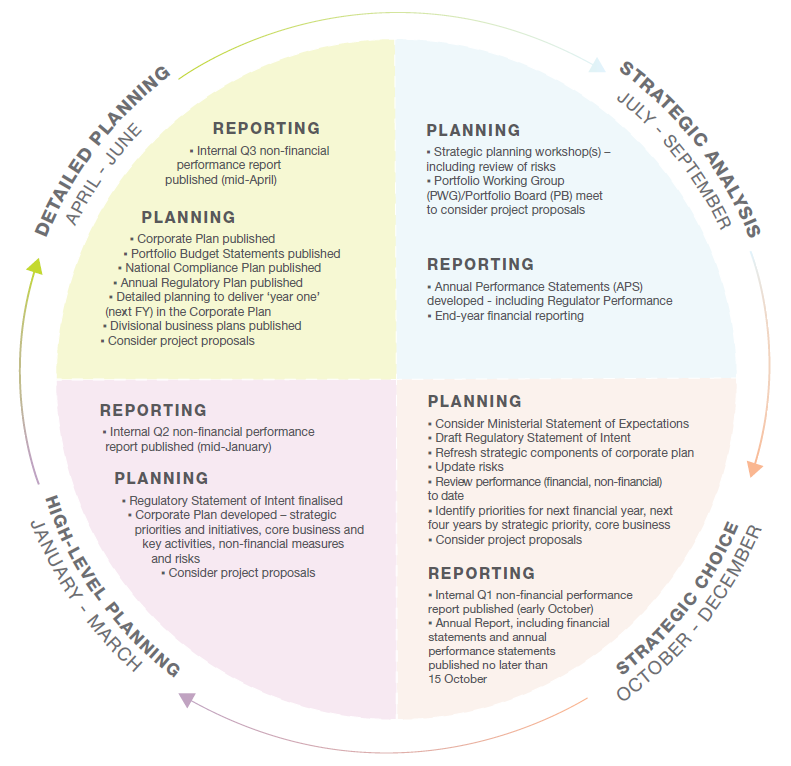4.1 Business policy
AMSA’s mission is ensuring safe vessel operations, combating marine pollution and rescuing people in distress. Our legislation, the Australian Maritime Safety Authority Act 1990 identifies the key functions we must deliver to the Australian public and the broader maritime industry. We acknowledge the traditional custodians of the country we operate in; we recognise and respect their elders past and present, their continuing culture and their ongoing connection to waters, lands and communities.
Our Corporate Plan details how we achieve our legislated role and our mission. It sets out our strategic priorities, new capabilities, and our core business. We account for our progress internally through quarterly reporting and annual management reviews and externally, in our annual performance statements in our Annual Report. In delivering our mission, AMSA is committed to providing the highest quality services, enhancing our environmental performance, upholding exemplary standards of workplace health and safety, and continually improving the way we do business.
We use an integrated management system to ensure that we achieve our mission and our commitments to each other and our stakeholders. The ongoing commitment to our integrated management system is highlighted through this business policy and certification to three international standards.

AMSA’s Executive is accountable for the effectiveness of and is committed to the continual improvement of the integrated management system. The Executive work with our Health, Safety and Environmental Committee and quality advisors to govern the system.
As an organisation, we:
- celebrate and harness the collective diversity of our people and maintain an inclusive and fair culture,
- comply with applicable local, national and international laws, regulations, standards and codes of practice,
- consult with and encourage participation of workers and their representatives on OHS matters and to create a safe and healthy working environment for the prevention of work- related injury and ill health,
- control hazards and threats using a risk based processes to identify, classify, prioritise, and eliminate the hazards and reduce the threats,
deliver our planned services and transparent and accountable regulatory decisions,

- demonstrate AMSA’s values of being professional, collaborative, dedicated and accountable, in our interactions with each other and with our customers and stakeholders,
- develop and achieve measurable business goals and targets that seek to manage risks and opportunities in continually improving the organisation, our integrated management system and our services,
- enhance and improve customer satisfaction with our services by listening and engaging with our stakeholders,
- foster a corporate culture that takes advantage of changes in our environment, opportunity and innovation and effectively manages business improvement initiatives,
- identify, implement, and improve the processes and documentation that support our integrated management system in meeting the requirements of the quality, environmental and occupational health and safety standards,
- minimise adverse environmental impacts through monitoring and where possible lowering our resource use, preventing pollution and acknowledging and protecting the environment and biodiversity of our sites, and
- encourage our goods and service suppliers to demonstrate the principles of the quality, environmental and occupational health and safety standards as set out in our contractual arrangements.
As individuals we:
- are responsible for quality, environmental and workplace health and safety practices in our own areas,
- recognise and eliminate hazards in our work environment, and help create a safe work environment,
- minimise our individual impact on the environment,
- maintain documented processes and procedures,
- participate in improvement activities, and
- work closely and cooperatively with each other, contractors, suppliers, clients and stakeholders to understand and meet their needs.
4.2 Compliance summary
The below tables demonstrate our compliance with the corporate plan requirements under the PGPA Act and Rule, and the AMSA Act.
PGPA Act compliance
Compliance with subsection 16E(2) the Public Governance, Performance and Accountability Rule 2014, subsection 35(1) of the PGPA Act 2013, and Resource Management Guide 132 – Corporate Plans for Corporate Commonwealth Entities.
Topic | Matters to be included | Corporate plan reference |
Introduction | The following: • a statement that the plan is prepared for section 35(1)(b) of the PGPA Act • the reporting period for which the plan is prepared, and • the reporting periods covered by the plan. | Introduction |
Purposes | The purposes of the entity | Introduction |
Key activities | Key activities that an entity will undertake during the entire period of the corporate plan to achieve its purpose. | Part 2: Strategic priorities, performance, risk and core business |
Operating context |
|
|
Environment | The environment in which the entity will operate for each reporting period covered by the plan. | Chair’s Foreword Part 1: Strategic framework |
Performance | For each reporting period covered by the plan, a summary of: • how the entity will achieve the entity’s purpose, and • how the entity’s performance will be measured and assessed in achieving the entity’s purposes, including any measures, targets and assessments that will be used to measure and assess the entity’s performance for the purposes of preparing the entity’s annual performance statements for the reporting period. | Part 2: Strategic priorities, performance, risk and core business |
Regulatory Performance | Integration of regulatory performance, regulatory principles and Statements of Expectations and Statements of Intent. | The key activities are the objects of the AMSA Act 1990, as depicted in the Plan on a Page on page 28 |
Capability | Entities are expected to describe an entity’s current capability and assess how its capability needs may change over the term of the corporate plan. They may also outline the strategies they will put in place to build the capability they need. The key strategies and plans that the entity will implement in each reporting period covered by the plan to achieve the entity’s purposes. | Capability programs are identified throughout the report by the [ICON] mark. |
Risk oversight and management | A summary of the risk oversight and management systems of the entity for each reporting period covered by the plan, including: • how risk management underpins their approach to achieving their purposes, and • identify specific risks in its environment, and how these risks will shape the activities to be undertaken to fulfil its purposes. | Part 1: Strategic framework Part 2: Strategic priorities, performance, risk and core business |
Cooperation | Discussion of any organisations or bodies with which the entity cooperates that make a significant contribution to achieving the entity’s purpose. | Part 3: Connections and cooperation |
AMSA Act compliance
This Corporate Plan meets the general requirements of the AMSA Act as follows.
AMSA Act reference | Matters included | Corporate plan reference |
Part 4, Section 25 (5) | The plan must include details of the following matters: • analysis of risk factors likely to affect safety in the maritime industry • human resource strategies and industrial relations strategies | Part 2: Strategic priorities, performance, risk and core business |
Part 4, Section 25 (6) | The plan must also cover any other matters required by the Minister, which may include further details about the matters in subsection (5). | See PGPA compliance table above |
Part 4, Section 25 (7) | In preparing the plan, the members must take account of notices given under section 9A. | N/A |
Internal compliance
We implement AMSA’s business policy (see 4.1 above) through an integrated planning, budgeting and reporting process.
The below image depicts our generic annual process.
